The Autumn Nations Series concluded at the weekend, with the Wallabies mounting an incredible comeback against Wales in Cardiff, while South Africa ended their tour on a high with a resounding win over England at Twickenham. We take a look at where those games were won and lost and look at some of the positives for each team in this year’s series.
To jump to our quick data hit on each team’s series click on their name below:
Argentina ••• Australia ••• England ••• Fiji ••• France ••• Georgia ••• Ireland ••• Italy ••• Japan ••• New Zealand ••• Samoa ••• Scotland ••• South Africa ••• Wales
Wales 34-39 Australia
The Principality Stadium played host to two teams seeking to finish 2022 with a flourish after what can only be described as a mixed year, which included surprise defeats to Georgia and Italy for Wales and Australia respectively in this year’s Autumn Nations Series.
When Gareth Anscombe converted Rio Dyer’s try in the 53rd minute to put Wales 21 points ahead, it seemed almost certain that it would be Wales rounding off their year with a victory. However, in keeping with the tradition of monumental comebacks in this year’s Autumn Nations Series, the Wallabies scored 26 unanswered points to leave Wayne Pivac, and indeed all of Wales, scratching their heads as to just how they managed to snatch defeat from the jaws of victory in such dramatic fashion.
While Wales were helped by two Australia yellow cards either side of the interval, it was two sin bins, for Justin Tipuric – his first in Test rugby since 2013 – and Ryan Elias, which would prove to be the catalyst for their downfall. Whilst the Wallabies had already restored some hope through Mark Nawaqanatiwase’s try in the 58th minute, his first ever in Test Rugby, Wales still looked to be coasting to victory before Tipuric was sent to the bin for a trip on Pete Samu in the 66th minute. After that incident, Australia entered top gear, registering more line breaks (four) and gaining almost as many metres (172m) in the last 14 minutes as they did in the first 66 (three line breaks and 201m), with Wales powerless to resist as Lachlan Lonergan crossed for the game-winning try in the 78th minute.
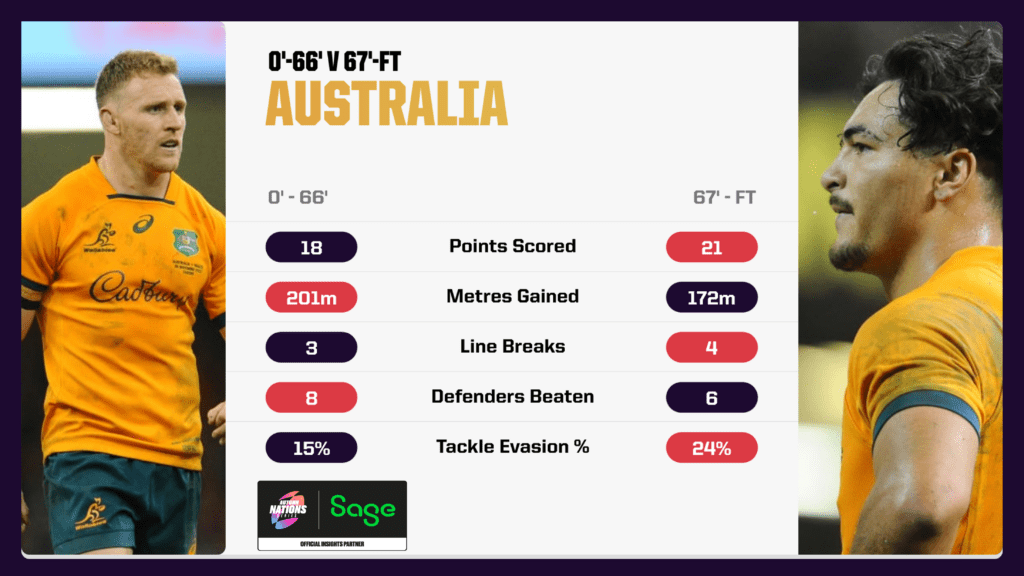
Whilst the end of the match will have undoubtedly been a bitter pill for the Welsh contingent to swallow, there were still some causes for optimism when looking at the full 80 minutes as a whole, with Wales’ 34 points being the most they’ve scored against Tier 1 opposition since March 2021 (48 vs. Italy). They also registered a 100% lineout success rate (12/12) for the first time since March of this year (9/9 vs. France), and a 99% success rate on their own rucks for the second time in three matches (also 99% vs. Argentina) after previously not doing so since March 2020 (99% vs. England). With the likes of Jac Morgan – who scored more tries than any other forward in this year’s Autumn Nations Series (four) – still developing, there’s plenty of scope for them to enjoy a more fruitful 2023.
England 13-27 South Africa
Eddie Jones will have been hoping his side carried on from where they left off in the last 10 minutes against New Zealand last week, as they mounted a fantastic comeback to recover a draw from what seemed to be an insurmountable 19-point deficit against the All Blacks. However, a mixture of poor discipline, handling errors and an uncharacteristically poor kicking display from Owen Farrell meant that England finished their year with a comprehensive loss.
Having converted all 15 of his previous attempts at goal in this year’s Autumn Nations Series, Farrell stepped up to take a penalty in the ninth minute which the average kicker would have been expected to score 94% of the time based on Opta’s kick prediction model. However, Farrell pulled his effort wide, setting the tone for an England performance which would be frayed with individual errors, no doubt causing great concern for Eddie Jones.
England made 21 handling errors throughout the course of the match, at least four more than any other Tier 1 nation in a single match in this year’s Autumn Nations Series, and if there’s one thing you can’t afford to do against the World Champions, it’s make unforced errors, because they will punish you, as the Springboks inevitably did. The ran up a 21-point lead by the 60th minute, which included a rare collector’s item in the form of a try for Eben Etzebeth, his first in 55 Tests for South Africa.
One player for whom scoring tries certainly hasn’t become a novelty though is Kurt-Lee Arendse, who duly finished off a devastating counter-attack to grab his seventh in seven caps for South Africa and ensure he finished as the top try-scorer in this year’s Autumn Nations Series, with five. Arendse has gained 130+ metres in each of his last two Tests, no other Springbok has gained 130+ metres on more than one occasion since Opta have recorded that data (2010).
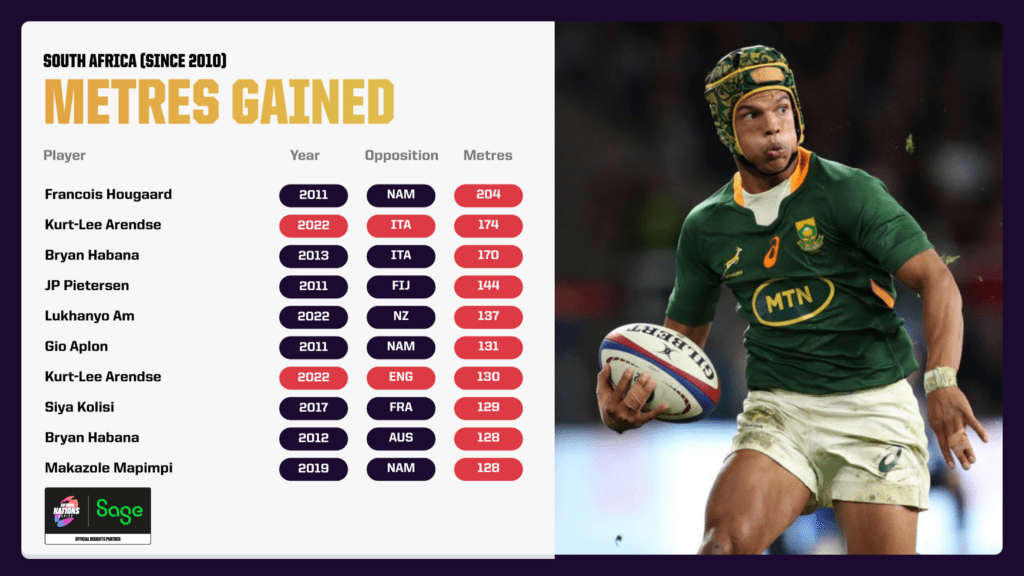
England were served a glimmer of hope in the 60th minute when substitute Thomas du Toit saw red mere minutes after entering the field, however South Africa held firm to claim a result which will leave them very satisfied and quietly optimistic of becoming just the second team to retain the Webb Ellis Cup after New Zealand did so in 2015.
England will no doubt be reeling from this result, and indeed 2022 as a whole. However, one thing that Eddie Jones has proven time and time again in his coaching career is that his sides should never be written off heading into a World Cup year, having consistently surpassed expectations when the stakes are at their highest.
The Positives…
Argentina
It has been a largely positive year for Argentina, recording a series win over Scotland in July before recording victories over Australia and New Zealand in The Rugby Championship, before picking up a first win against England since 2009, in this year’s Autumn Nations Series. The win halted a run of 10 straight defeats to England and was their first win at Twickenham since 2006. When they had ball in hand for a continuous period the Pumas showed how dangerous they can be – 59% of their carries committed at least two tacklers, a rate only New Zealand could better of the sides that featured more than once this autumn (61%). If Argentina can reduce their penalty count and string together longer passages of possession, they will be difficult to contain.
Australia
If there’s one thing Australia brought to the Autumn Nations Series it was drama. They played five games in this year’s series with the first three being decided by a single point, before a three-point loss to Ireland and a dramatic comeback win against Wales which again was decided by a margin of less than a converted try. Australia were riddled with injuries and player unavailability during the autumn so perhaps the most pleasing thing will be the experience gained by fringe players on this tour. The Wallabies used 36 players over the last month, more than any other team and one of the fresher faces who stood out this autumn was Mark Nawaqanitawase who was the top-ranking Wallaby for tries (two) defenders beaten (15), line breaks (three) and offloads (seven – only Finn Russell (nine) made more). He’s certainly one of the players to watch at next year’s World Cup.
England
England had a disappointing Autumn Nations Series, although there are signs that if they do click, they can be a force to be reckoned with, particularly taking into account their last 10 minutes against New Zealand when they came to life and caused the All Blacks all sorts of problems. In particular, their offloading game was a source of joy, they created five line breaks from offloads in the last month, more than any other team, as well as assisting a further two tries from offloads – only Scotland and Samoa could better that tally (three each). England struggled to generate quick ball this autumn but if they can boost those numbers, it will give their playmakers the time and space to get their back line ticking. Interestingly, 63% of England’s 22 exits in the autumn came via carries, by far the highest rate of any team – it will be interesting to see if their intent to attack from deep continues in 2023.
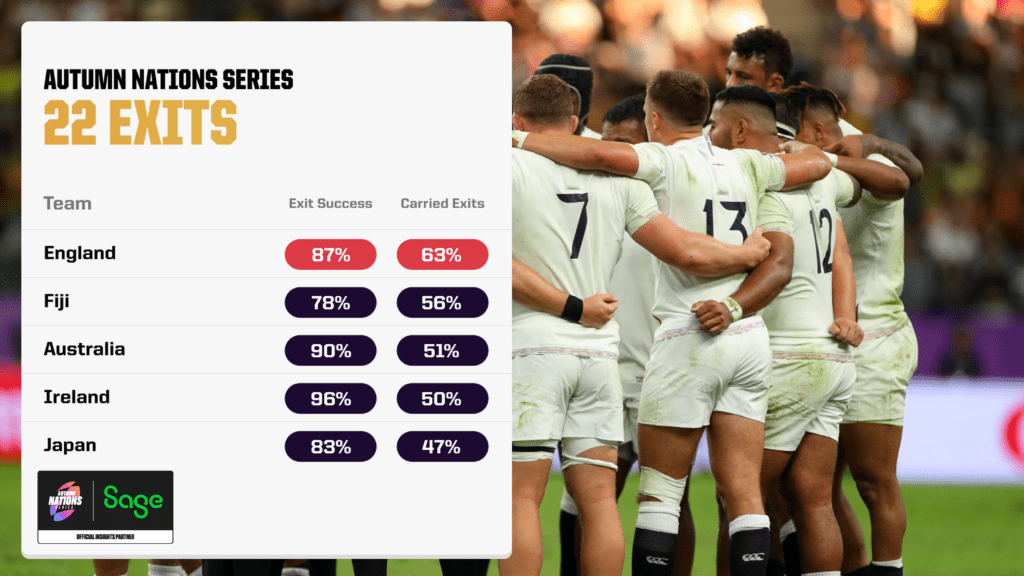
Fiji
This autumn Fiji showed us glimpses of what we have come to expect from them: running rugby and audacious offloads. Despite some indiscipline letting them down, they still managed to give Scotland and Ireland some uncomfortable moments, namely their first half at BT Murrayfield and their second half – when reduced to 13 men at times – in Dublin. If they can piece together a full 80-minute performance, they can run anyone close. Fiji gained 433 metres per game in November, recording an average of 4.8 metres gained per carry, the best rate of any nation over the Autumn Nations Series and a sign that they are not to be taken lightly.
France
The biggest positive for France in this year’s Autumn Nations Series was recording a perfect record and thus ensuring they ended the year with a 100% win rate for the first time in their history (min. three games). They almost recorded a perfect year back in 1998 before the Wallabies beat them in their final game of the calendar year – back then the Wallabies would beat France again 12 months later in a World Cup final. Whether France closing out the year with a perfect record says anything about whether they can also go the distance in the Rugby World Cup remains to be seen, but Les Bleus have the building blocks to go deep in the tournament and beat any team.
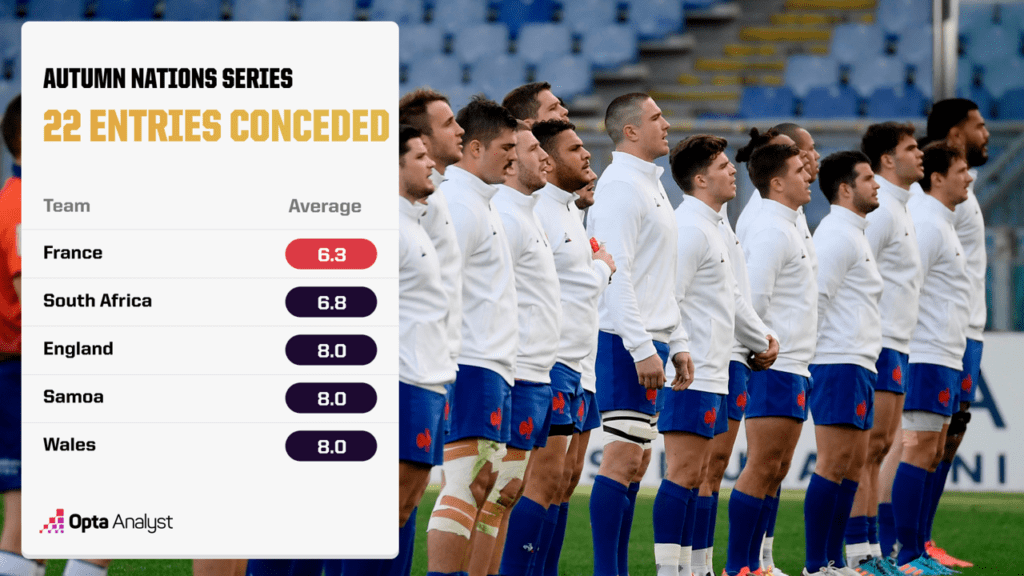
Defensively they give up few chances, conceding just 6.3 22 entries per game, fewer than any other team in the last month and that is potentially helped by having the joint best 22 exit success rate (96%, level with South Africa and Ireland). 65% of France’s 22 exits in the autumn came via kicks, suggesting this France team know when to clear their lines, rather than taking the risk of attacking from deep – we know they can do it, but there is a maturity in this Les Bleus side that suggests they know when to take the conservative approach.
Georgia
It’s been a positive 2022 for Georgia. Having beaten Italy at home in July they went on to record their first ever away win against a Tier 1 nation, meaning they end the year with a perfect record against Tier 1 nations after never previously winning against this level of opposition before. Their victory in their solitary Autumn Nations Series game was built upon the foundation of a strong set piece – something Georgia had always been proud of but had perhaps lost their edge in recent years. But not against Wales, they had a perfect rate at the lineout (10/10) and won nine of their 10 scrums, winning three scrum penalties at important points in the match. They defended incredibly too – their 94% tackle success rate was the joint best of any team in an Autumn Nations Series game this year (Scotland 94% v Fiji).
Ireland
Ireland went through the Autumn Nations Series unbeaten, a feat they’re starting to become accustomed to in recent years, beating South Africa, Fiji and Australia. Much of their success was built on a strong defence rather than their attack which didn’t quite click in the autumn as it had done earlier in the year, however Ireland will be pleased to have recorded a 100% record without playing their best rugby. Of teams that played more than once in the Autumn Nations Series, Ireland conceded the fewest points per 22 entry (1.6), helped largely by the fact that of their 70 missed tackles in the autumn, 84% saw the opposition player tackled immediately after, before a line break or a try was conceded – the best rate of any nation. They also had a 22 exit success rate of 96%, the same rate as France and South Africa – no team to play more than once in the last month had a better rate at getting out of their 22 unscathed.
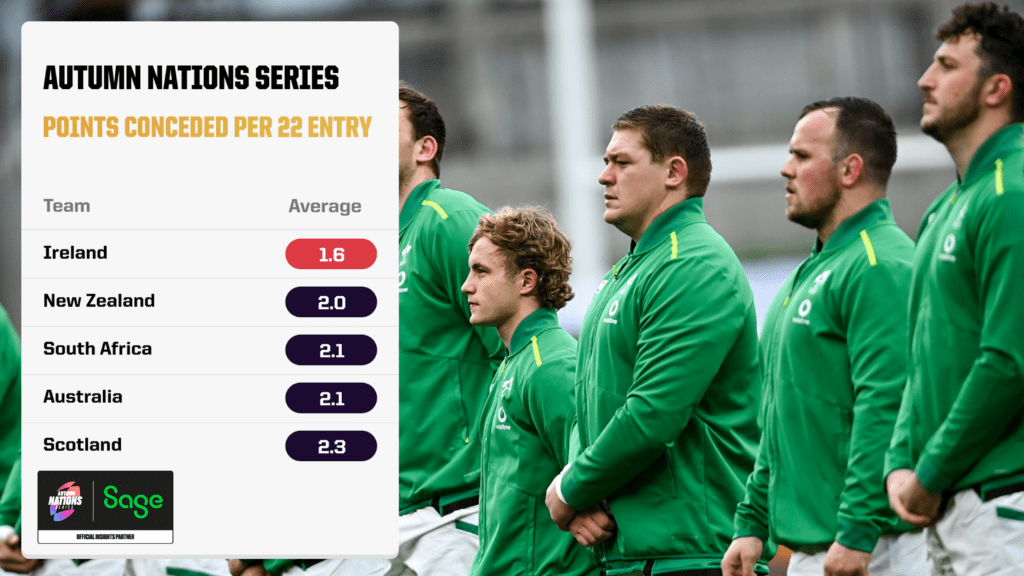
Italy
Italy’s attack has been much improved this year and they took it to another level this autumn. The Azzurri averaged the joint most line breaks per game of any nation, making six per game (level with Scotland and Samoa) and recorded the best tackle evasion rate (31%). They were also clinical in the red zone, averaging 3.1 points per 22 entry – a tally only the All Blacks could better during the last month of rugby. However, the most pleasing thing for Italy will be the level of opposition they posted those numbers against, winning their opening game against Samoa, before an historic first win against the Wallabies and then going toe-to-toe with the Springboks for 45 minutes in Genoa before ultimately falling away. However, there are plenty of positives for Italy to take into the new year and they will be a tricky proposition in the Six Nations.
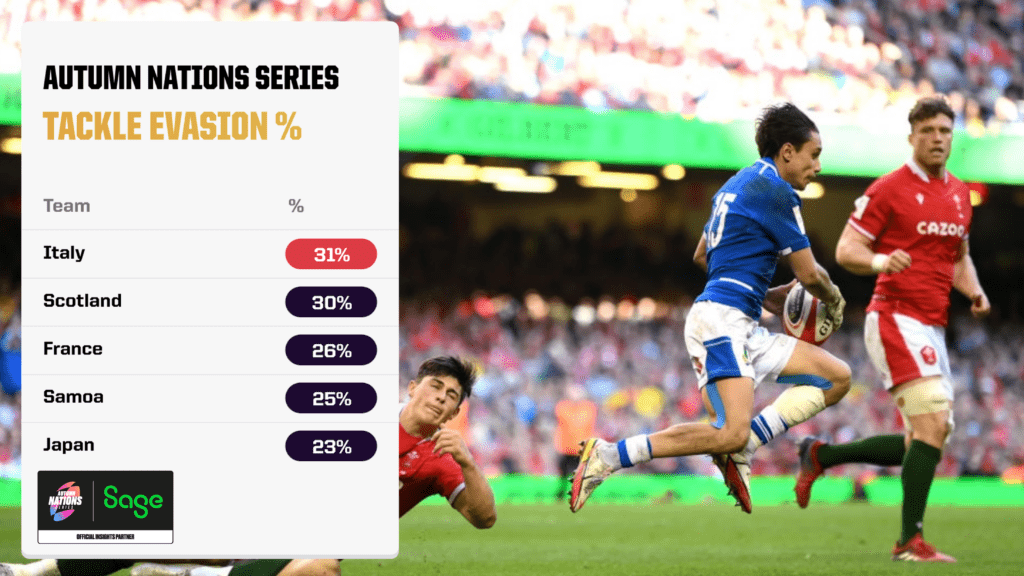
Japan
While Japan didn’t quite get the results they might have hoped for, they still showed glimpses of their unpredictable attacking play during this year’s Autumn Nations Series and much of that was down to their rapid ruck speed. Of all the teams to feature in this year’s series, Japan had the highest rate of rucks under three seconds, with 67% of their breakdowns being completed in that time frame. That led to some beautifully constructed tries for the Brave Blossoms, and it serves as a reminder of the damage they can do when they click.
New Zealand
It’s difficult to gauge exactly where New Zealand’s game is at currently, after a disappointing year by their incredibly high standards. However, they are still incredibly difficult to defend against and are able to create tries from seemingly nothing. The All Blacks averaged more carries per game than any other team in the Autumn Nations Series (116) and on top of that they committed two or more tacklers from 61% of those carries, the highest rate of any nation to feature more than once in the series. That helped New Zealand create gaps in other areas of the pitch which they were able to exploit, averaging the most points per game of any team in the series, as well as scoring four points per 22 entry, comfortably the best rate of any team in the red zone.
Samoa
Samoa will have been disappointed with their outing against Italy in this year’s Autumn Nations Series, but they did finish with a flourish and give themselves something to build on as they prepare for the Rugby World Cup next year. Their offloading game certainly gave Italy much to think about when they side met earlier this month, with Samoa recording three try assists from offloads, a tally no other team could better throughout the entire series combined. They also recorded a further line break assist from one of their offloads meaning that 44% of their offloads against Italy yielded either a try or a line break, something for the teams in Pool D to be wary of at next year’s World Cup.
Scotland
Scotland had a mixed autumn, but there were certainly plenty of positives. They showed signs of being back to their attacking best, with Finn Russell coming back into the fold and pulling the strings to allow their electric back three the time and space to cause opposition defenders nightmares. Scotland averaged 29 defenders beaten per game, the highest tally of any team in the Autumn Nations Series, also averaging a joint high six line breaks per game (level with Italy and Samoa).

South Africa
Diminutive wingers in scrum caps stepping English playmakers is becoming somewhat of a theme for the Springboks. Kurt-Lee Arendse’s try against England was just the cherry on top of a top-class Autumn Nations Series, rather than a breakthrough moment. Arendse was the top try scorer in this year’s series, but those scores weren’t just a case of being in the right place at the right time – the Bulls flyer was at the heart of much of South Africa’s attacking play in November. He also gained the most metres of any player, averaging 12.1 metres per carry – the best rate of anyone to make 10+ carries, while no one could better his tally of seven line breaks (level with Darcy Graham).

In Cheslin Kolbe and Makazole Mapimpi South Africa have two world-class wingers and if this last month is anything to go by, the Boks have unearthed another. As a team South Africa will also be pleased with their abrasive ball carrying – 31% of their carries were dominant, the best rate of any team, but you already knew that didn’t you…!
Wales
While it wasn’t a vintage month of rugby for Wales there were still positives to take. For one, their maul functioned well and if that can become a weapon for them it will give them a great attacking outlet even when they aren’t playing their best rugby. Of teams to feature more than once in the Autumn Nations Series, Wales were the only one to record a 100% maul success rate, not giving away possession from any of the 18 mauls they set in November, with those mauls yielding two tries, a tally only Ireland and Australia could equal, while they averaged 3.6 metres gained per maul – only France (4.3) and New Zealand (3.7) average more. It’s also great to see Gareth Anscombe back and firing in a Welsh jersey again following his injury troubles – he slotted 14/14 kicks at goal in the last month, the only player to record a 100% rate (min. 5 attempts).
Enjoy this? Subscribe to our mailing list to receive exclusive weekly content.
